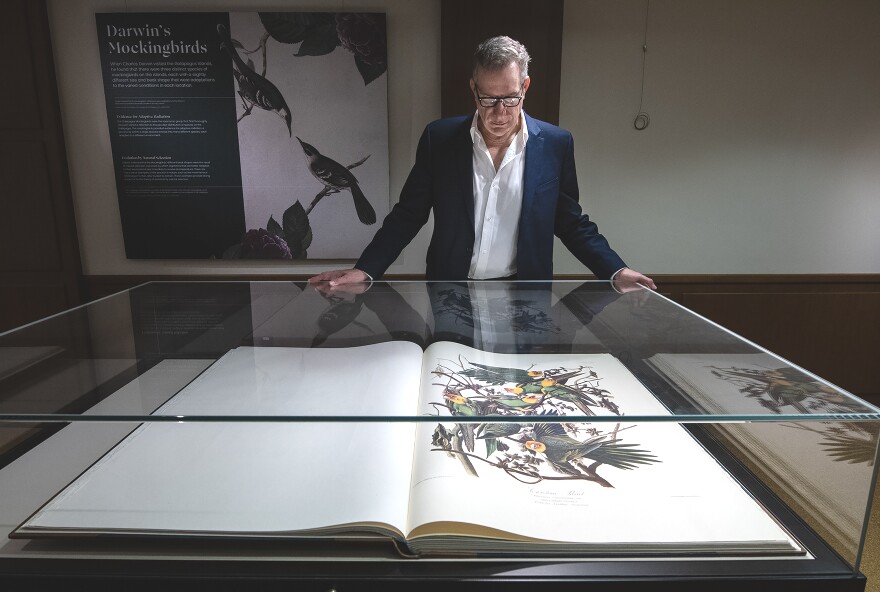Kansas City’s Linda Hall Library of Science, Engineering and Technology is one of the largest science research libraries in the world. The library's collection numbers in the millions and includes original works from Nicolaus Copernicus, Galileo Galilei and Isaac Newton.
For the next several months, the library hosts “Chained to the Sky: The Science of Birds, Past & Future,” a free, three-part exhibition that follows the study of birds throughout history and poses new questions about the future of bird populations.
Eric Dorfman, the library's president and CEO, is relatively new on the job. Before taking over as president on July 10, Dorfman lived in North Carolina, where he directed the North Carolina Museum of Natural Sciences and served as a research professor at North Carolina State University.
"I do have a I have a love of all things living, but I do have a special place for cormorants and other large waterbirds, egrets, ibis, herons and pelicans," he says. "So when we thought about what exhibition to start with, birds really felt like something that we could hit the ground running with."

Besides featuring items on loan from Chicago’s Field Museum, the library has brought out many rare books from its collection. Dorfman worked closely with Eric Ward, vice president for public programs, to help choose scientific volumes for display.
“One of the highlights of the exhibition is the display of the breadth and depth of the library's ornithology collection,” Ward says. “Books from the 16th through the 19th century will be on display, including two great works in the 19th century."
One of those books is a highlight of Victorian natural history. “A Century of Birds from the Himalaya Mountains” was published in London in 1831. It opens to a hand-colored, lithographic plate of an imperial pheasant by ornithologist John Gould and his wife, Elizabeth, who was a very talented artist.

Another book is from 1599, by Italian naturalist Ulisse Aldrovandi, a prolific collector of natural history specimens from birds, mammals, insects and fish. The first three volumes of his natural history encyclopedia were on birds. In the exhibit, Aldrovandi's book is opened to a beautiful woodcut of a fierce-looking Osprey with a flying fish in its talons.
But the exhibit comes at a time of crisis for birds.
“Those who study birds actively are warning about the dire state of North American birds,” Dorfman says in the press release about the exhibit, noting that “bird populations on our continent have declined by more than 3 billion in the last 50 years, causing dramatic changes in our natural animal and plant ecosystems.”

The exhibit also shows that the impact of humans on bird populations has been ongoing. Bird study skins on loan from the Field Museum include two birds lost to extinction: the Carolina parakeet, the ivory-billed woodpecker and the passenger pigeon. A glass case serves as a sort of mausoleum for the birds.
Dorfman says the parakeet serves a kind of symbol of the exhibition. It was the only parrot native to North America.
"The Carolina parakeet had a habit of eating farm crops and so it was not well-loved," he says. "The other sad thing about it is that they were quite tame, and so a farmer would come and shoot a tree full of parrots. They would fly out and then immediately fly back to the same tree and look to their fallen comrades and try and figure out what was wrong with them. And then the whole flock would be, in that way, decimated."

Dorfman says the museum's strong message of conservation is meant to help visitors appreciate the birds we can see in our backyards and do what they can to help.
In addition to the exhibit, the Library’s 14-acre arboretum provides an example of bird conservation strategies in an urban setting. More than 20 unique bird species can be observed using the arboretum for feeding and nesting. The library invites visitors to spend time in the arboretum observing native species using the same methods pioneered by naturalists like Darwin and Audubon.
“Chained to the Sky: The Science of Birds, Past & Future" opens Nov. 10 and continues through April 26, 2024. The exhibition is free and open Monday–Friday 10 a.m.-5 p.m. and 10 a.m.-2 p.m. the second Saturday of each month at the Linda Hall Library, 5109 Cherry Street, Kansas City, Missouri 64110.
Disclosure: The Linda Hall Library is a financial supporter of KCUR.





